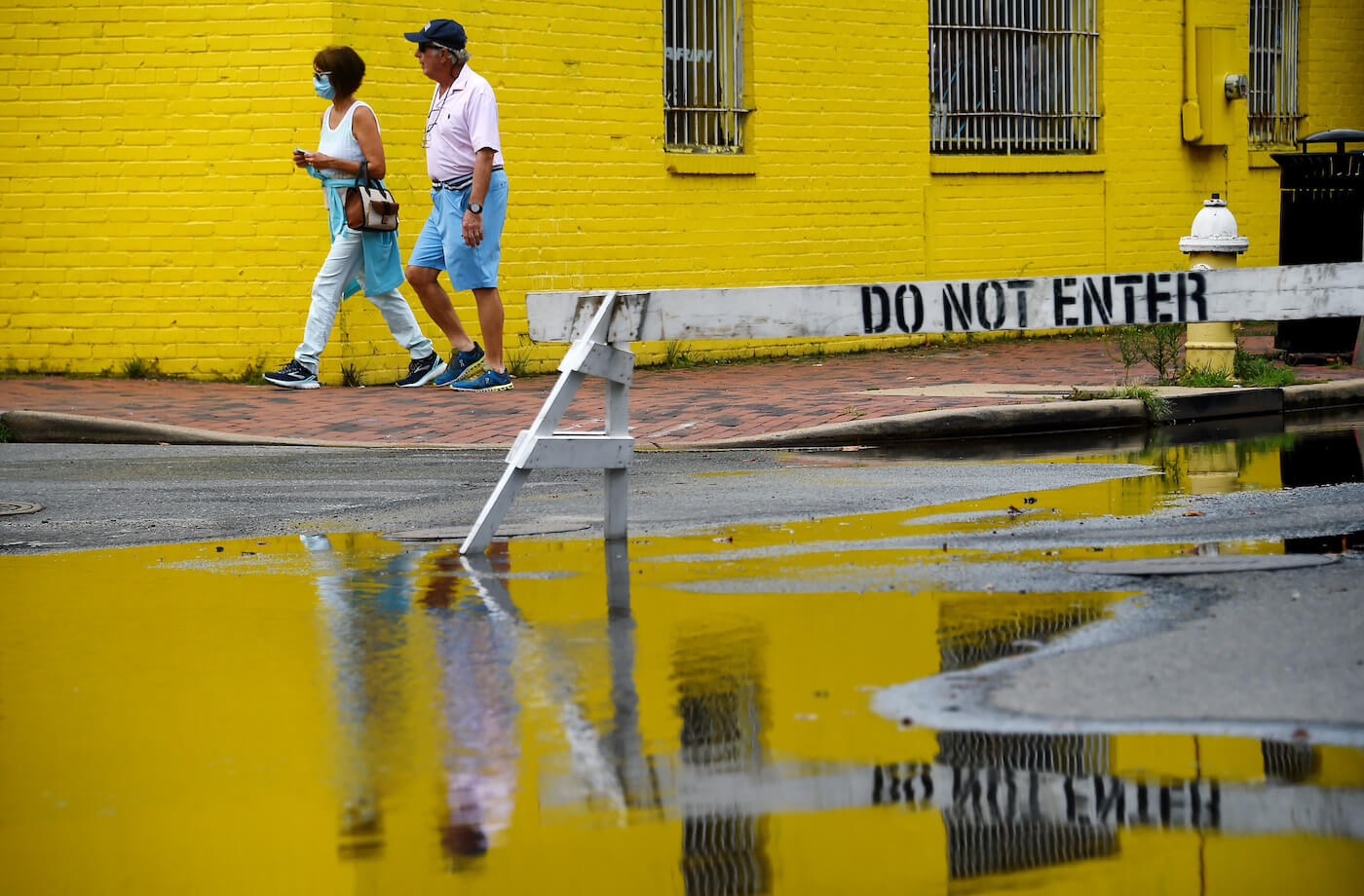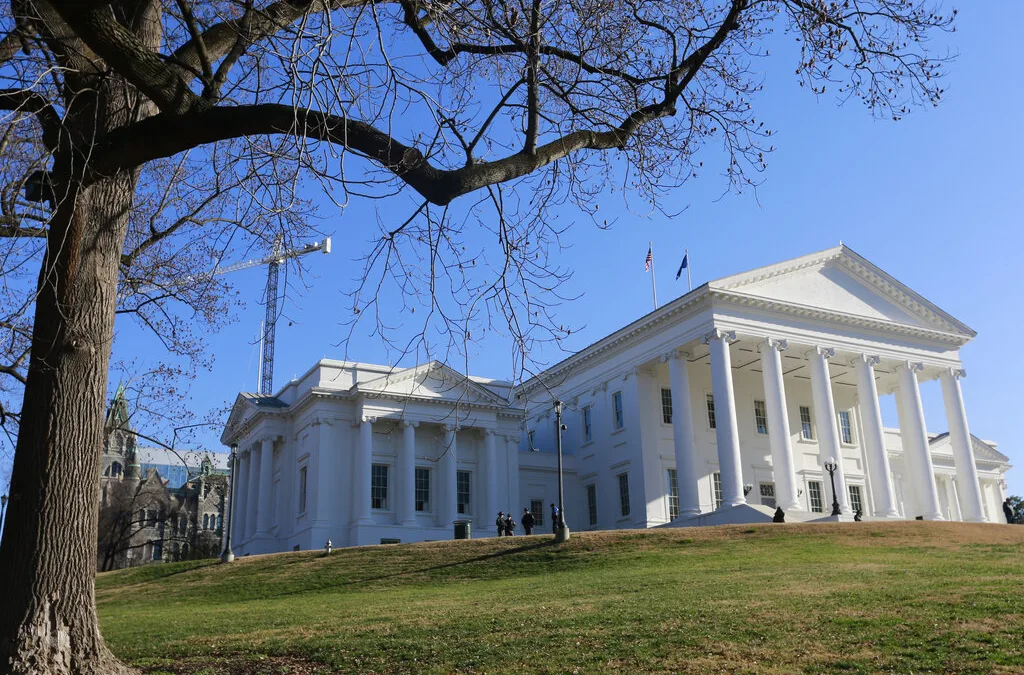
People walk past a flooded street in old town Alexandria, Virginia. (Photo by OLIVIER DOULIERY/AFP via Getty Images)
The Biden infrastructure bill includes massive funding for projects that could make Virginia roads, bridges, homes, and businesses better equipped for floods and high winds.
Virginia has become one of the stormiest places in the country this year, with more severe thunderstorm warnings than any other region in America.
That is not the norm, according to the Washington Post. Usually, it is the central United States and the deep South that sees the highest number of storms. And with those storms came historic rainfall and flooding across the state, damaging countless homes and businesses, and stranding drivers on dangerous, washed-out roadways.
In August, for example, Gov. Ralph Northam issued a state of emergency after Tropical Depression Ida brought heavy rainfall and flooding in Southwest Virginia. At least one Virginia resident died as a result of the storm that killed dozens from here to the northeast.
The inundation of water and wind in the state this summer helped put a spotlight on legislation that was working its way through Congress at the same time: the Biden infrastructure bill.
Passed by the US Senate in August, the legislation—dubbed the Infrastructure Investment and Jobs Act—includes a historic investment in protecting American communities from flooding, and making sure they are prepared for ongoing challenges.
According to the Pew Charitable Trusts, there are a few key ways the Senate-passed legislation could help address flooding. The bill:
- dedicates $1 billion to a program that helps communities plan and build projects to withstand extreme weather before it hits.
- more than triples grant awards available through FEMA’s flood mitigation program, which helps people reduce the risk of repetitive flood damage.
- dedicates nearly $9 billion to help state and local governments assess, plan, and build projects that specifically reduce how vulnerable roads and bridges are to natural disasters (i.e., getting washed out by a flood).
- makes clear that federal highway funding should consider and include weather resiliency projects, in addition to safety and traffic congestion.
- funds research on how to make infrastructure more resilient to weather events, for example, developing permeable pavements that can help combat flooding.
- adds natural solutions, like preserving or restoring wetlands, to federal programs that try to reduce damage to transportation systems.
The US House is currently considering the infrastructure package. Rep. Abigail Spanberger, a Democrat who represents areas outside of Richmond, says its passage would be a win for the state.
“Here in Virginia, we have made tremendous progress in making our Commonwealth the best place in the country to start a business, work, and raise a family — but we can do more to shore up our economy for the long run. This infrastructure package would ensure that Virginia continues to lead the way,” Spanberger said in a statement. “By moving this bill forward, we can keep the United States competitive in the face of rising international competition from nations like China. We can make our infrastructure more resilient to the climate crisis.”
The investment can’t come soon enough. A June report from the Virginia Academy of Science, Engineering, and Medicine on the impact of climate change on Virginia’s coastal areas found that “more intense and frequent storms” are an immediate consequence of increased greenhouse gases in the atmosphere due to pollution.
READ MORE: Want to Reduce Virginia’s Flooding Problem? There’s a Tool for That

VIDEO: Your support matters!
Your support matters! Donate today. @vadogwoodnews Your support matters! Visit our link in bio to donate today. #virginianews #virginia #community...

Op-Ed: Virginia’s new Democratic majorities pass key bills to improve your lives, but will Youngkin sign them?
The 2024 Virginia General Assembly regular session has wrapped up. It was a peculiar session from the outset, with Democratic majorities in the...

Op-Ed: Why Virginia Needs A Constitutional Amendment Protecting Reproductive Freedom
Virginia’s recent election season in 2023 drew in eyes from all over the country. Reproductive freedom was on the line and Virginia remained the...

From the state rock to the state flower, here’s how Virginia got its symbols
Have you ever wondered why the Dogwood is the state flower? Or how the cardinal became the state bird? We’re here to answer those questions and more...

VIDEO: Second-gentleman Douglas Emhoff gives speech on reproductive freedom
Second gentleman, Douglas Emhoff touched on reproductive freedom not only being a woman's issue but "an everyone's issue" during the Biden-Harris...

Glenn Youngkin and the terrible, horrible, no good, very bad night
Election Day 2023 has come and gone, and while there are votes to be counted, one thing is perfectly clear: Virginians unequivocally rejected Gov....





